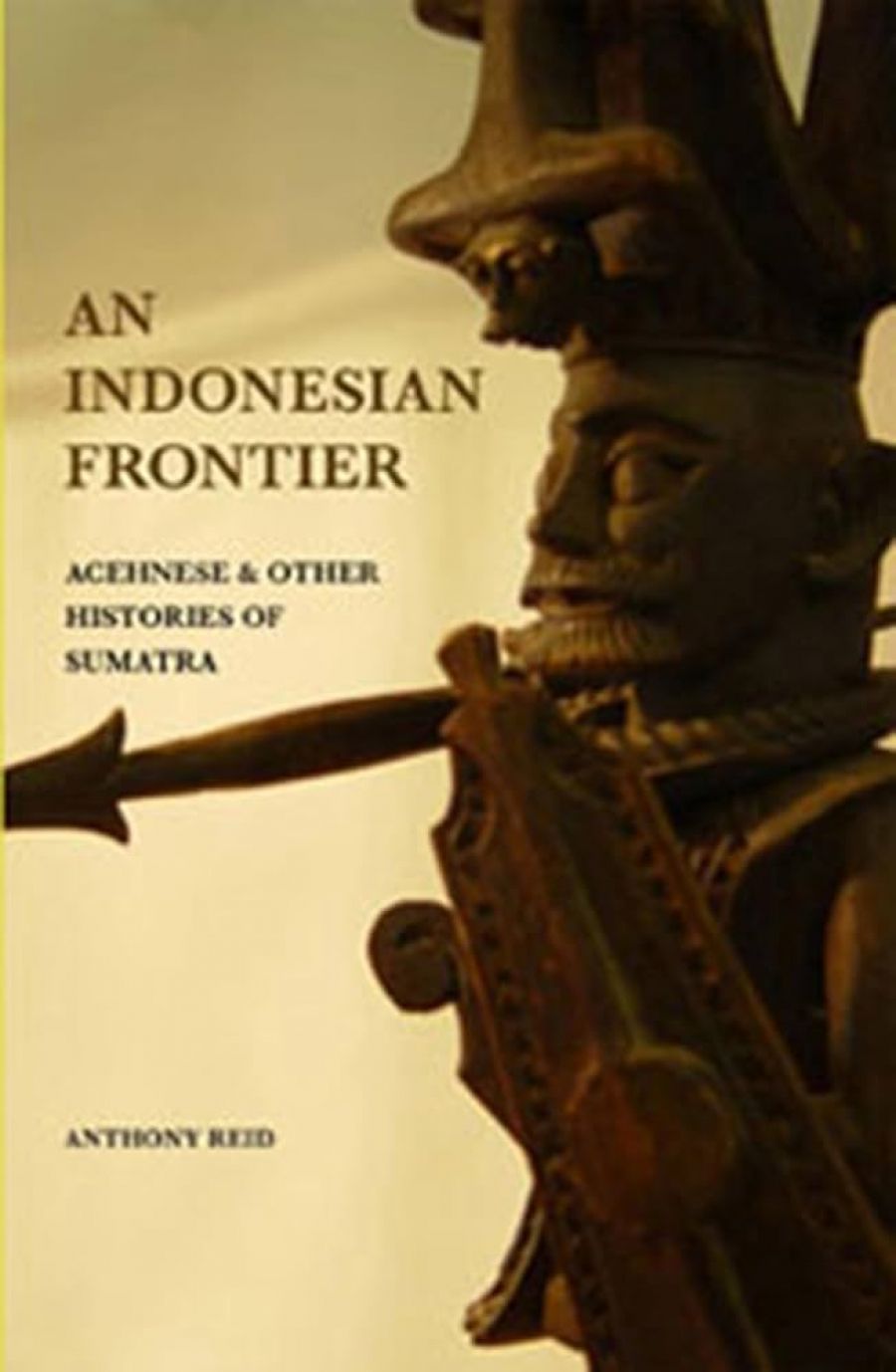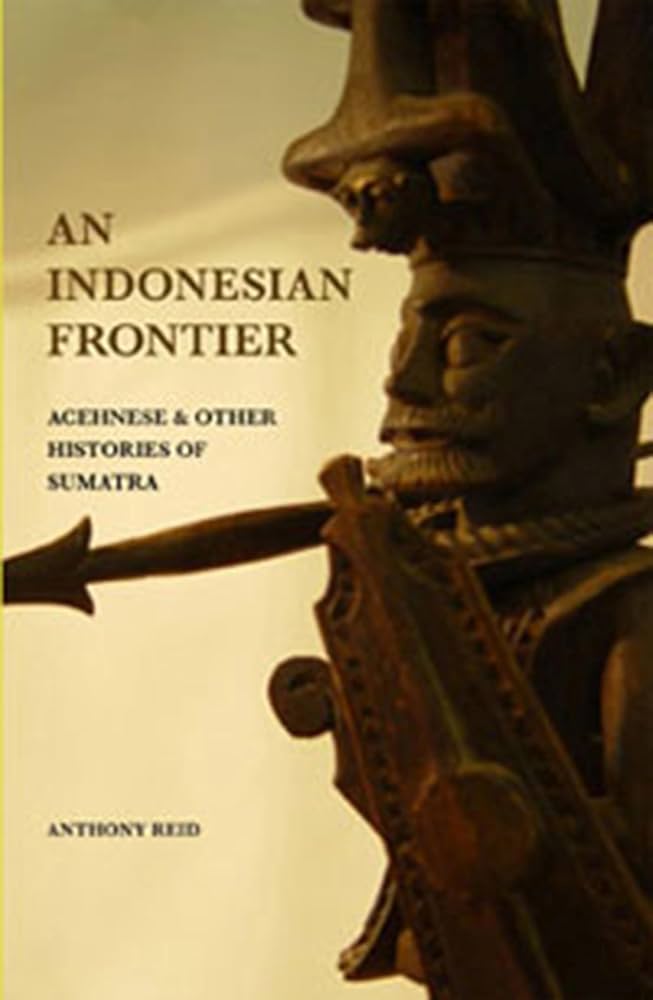
- Free Article: No
- Contents Category: International Studies
- Review Article: Yes
- Article Title: Challenges to the Indonesia project
- Online Only: No
- Custom Highlight Text:
Professor Anthony Reid has added this volume on Sumatra, with special attention to Aceh, to his already huge corpus of publications about Indonesia. The book reveals that he remains master of the telling phrase. In this case, the phrase emerges, almost casually, when he tells us that since 1998 the ‘Indonesia project’ has been increasingly challenged. Indonesians might be startled to learn that their country was a project, but Reid presents plenty of evidence here for its incompleteness. Anyone tempted to superficial judgments about the Aceh problem and what it means for Indonesia and the region would do well to read this book.
- Book 1 Title: An Indonesian Frontier
- Book 1 Subtitle: Acehnese and other histories of Sumatra
- Book 1 Biblio: Singapore University Press, $58.50 pb, 439 pp
- Book 1 Cover Small (400 x 600):

- Book 1 Cover (800 x 1200):

Reid modestly admits that the book is a compilation of his work on different aspects of Sumatra’s history over forty years, and ‘not the coherent and balanced history the island deserves’. Indeed, the chapter on the transition from royal autocracy in Sumatran kingdoms is written with someone else; the chapter on the Japanese occupation of Indonesia, including Sumatra, derives, according to a footnote, from fieldwork in Japan in 1973; and the final chapter is a reworking of a lecture on Aceh given in Canberra in 2002. Alas, a chapter on the fitful and inconclusive French interest in Sumatra and Aceh looks like padding. It is hard to see why this arcane material was included, as France was never really a player in Aceh or Sumatra as a whole; its omission would have allowed greater development of more central themes. Nevertheless, the whole is much greater than the sum of its parts.
In an introduction that serves as an excellent summary of the book, Reid announces a salient theme, with the admission that visits to Aceh in 2000 and 2003 obliged him to rethink his assumption that Aceh was firmly a part of Indonesia, albeit a restive and troubled one, because many more Acehnese than before were questioning their identity as Indonesians. For many Indonesians, especially those unaware of army misbehaviour in Aceh, this questioning is incomprehensible, because they have been taught to think of the Acehnese as exemplary anti-Dutch fighters in the 1940s revolution, and therefore of Aceh as the archetypically militant Indonesian province.
We learn from the book much background about other parts of Sumatra and about Aceh’s ancient history before we reach the modern era. We learn of the importance of gold and elephants for the Aceh kingdom, and of the grand ceremonies and parades held on Muslim festivals, aimed at impressing the people and foreign visitors with the wealth and dignity of the Sultan. We also learn that the cruel autocracy of the sultans, especially of Aceh’s greatest ruler, Sultan Iskandar Muda, so frightened the Acehnese nobles that they thereafter installed a series of female rulers on the throne, a startling occurrence for the reputedly strictest Muslim area of the archipelago. On other regions, we hear why Sumatra rarely, if ever, had a unified political identity. We learn about the Padri War in the Minangkabau region; about the large-scale importation of Chinese labour to Sumatra in colonial times and the problems arising from that; and about the equivocal role given to Sumatra during the Japanese occupation, which produced a very different political consciousness in Sumatra, compared with Java, during the Indonesian revolution.
Research by many scholars in far-flung archives has cast new light on the contacts between Aceh and Turkey, and with a variety of other European powers apart from the Dutch. The links with Turkey involved trade but also relied on international Muslim solidarity, which Aceh desperately tried to invoke when first under serious threat from the Dutch in the 1870s. In a fascinating chapter, we hear that the protracted and bloody Dutch conquest of Aceh, which completed colonial control over modern Indonesian territory, was encouraged by the extraordinary British merchant– imperialist W.H. Read, who somehow served as Dutch consul in Singapore for thirty years. Perhaps surprisingly, however, we are spared a blow-by-blow account of the war itself, which cost more than 100,000 Acehnese lives.
The inclusion of Aceh in Indonesia owes much to Dutch ambition, but it is the historical identity of Aceh as a thriving and independent Muslim polity for several hundred years that underpins modern Acehnese claims to independence. What is less emphasised is Aceh’s role in the Indonesian revolution of the 1940s, where, after the ulamas overthrew the rival class of nobles, the province governed itself smoothly as a militant part of revolutionary Indonesia and was the one region never entered by the Dutch. In this chapter, Reid gives us an elegant and instructive set-piece about the concept of ‘revolution’, and the reasons why the concept is an essential but slippery tool for historians.
Aceh’s willingness to be an Indonesian province during this period weakened its claims to independence in the eyes of the outside world, but peace lasted only a few years until a revolt broke out in 1953; Reid points out that this was based on Islam and not secessionism. He notes the way in which recent developments have forced historians to re-examine the role of Islam (and international Muslim links) in the archipelago as a force in itself, and not just as an adjunct to the Indonesian nationalism that characterised the 1940s. These two impulses interacted with the Aceh story in many complex ways.
In the final chapter, Reid gives us the history of Hasan Tiro, the exiled leader of the Aceh movement. It comes as a surprise to hear that the young Tiro once wrote: ‘As it was in the past, Aceh is an indivisible part of the Republic of Indonesia.’ Of course, he subsequently changed his mind, and came to regard Aceh as having been shamefully handed over in 1949 to ‘Javanese colonialism’. The new consciousness arose partly from his rediscovery of Aceh’s history while living for many years in New York. A further surprise in this leader of an assertively Muslim movement is his absorption in Western culture, especially classical music.
Reid concludes with an account of recent developments, especially the way in which greater freedom after Suharto’s fall greatly encouraged Aceh’s secessionism. He recounts in familiar terms the sad history of attempts at mediation, notably the short-lived peace agreement of 2000–01. He concludes grimly but accurately that Acehnese alienation appears likely to be consolidated by military heavy-handedness.
Since the book appeared, Susilo Bambang Yudhoyono has been elected Indonesian president and a new start may be possible. As a former general, he is well placed to be able to force local army commanders to enter into serious negotiations, if he musters the political will. The international effort to combat the appalling effects of the tsunami disaster may also have a positive result on Acehnese opinion. But the Aceh–Indonesia relationship has provided so many disappointments, from the 1950s up to the present, that it is almost heroic to be an optimist.


Comments powered by CComment